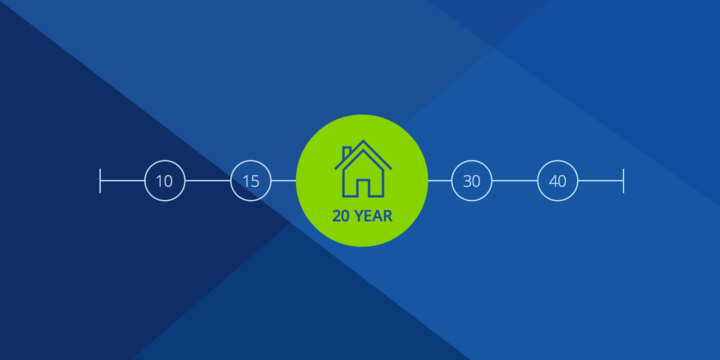Fixed-Rate Mortgage vs Adjustable-Rate Mortgage (ARM)


Written by Alycia Lucio on July 19, 2024
With today’s interest rates hovering around 6.5%*, you’re probably wondering whether it’s more beneficial to get a more traditional fixed-rate mortgage vs. an adjustable-rate mortgage (ARM) when you apply for a home loan. While a fixed-rate mortgage has an interest rate that remains the same until you pay off your loan, an adjustable-rate mortgage (ARM) is exactly what it sounds like; its interest rate can change on a regular basis after an initial fixed-rate period.
Both mortgage rate options have their advantages and disadvantages, and knowing the difference between fixed and adjustable-rate mortgages, can help you figure out which option best suits your financial goals, save you from paying additional interest on a home loan and help you budget out your monthly mortgage expenses. We’ll walk you through both types of mortgage rate options below.
What is a fixed-rate mortgage?
A fixed-rate mortgage is a home loan that has a set interest rate and repayment term. The interest rate is a percentage of your remaining mortgage principal. As you pay down your principal, a larger portion of your monthly payment will go towards your principal and a smaller portion towards your interest. Conventional, FHA, VA and USDA loans all come with a fixed-rate option. Fixed-rate mortgages have a 30-year mortgage term option, and some loan types also offer a 15-year mortgage term, so you can pay off your loan faster.
What is an adjustable-rate mortgage?
An adjustable-rate mortgage, also known as an ARM, floating-rate or variable-rate mortgage, is a home loan with an initial interest that is typically lower, but that can go up or down every six months after an initial fixed rate period. Common introductory rate periods for ARMs are 3-year, 5-year and 7-year, but 10-year ARMs are also available. The number of years represents how long the interest rate will be fixed on the loan before becoming variable for the remainder of the term. Most ARMs have a loan term of 30 years.
Differences between fixed and adjustable-rate mortgages
Budgeting for a fixed-rate mortgage is easier than an ARM
When budgeting for a home among all your other monthly expenses, it helps to know how much your mortgage will cost you each month. A fixed-rate mortgage will have an interest rate that remains the same for as long as you have the loan. An adjustable-rate mortgage will only have a fixed interest rate for the first three to 10 years and then a variable rate for the remainder of the term. This means the amount you pay in interest each month could increase with an ARM but not a fixed-rate mortgage — impacting your monthly mortgage expense.
Luckily, all mortgages come amortized, so you can see how much of your monthly payment will go towards paying off your principal loan balance and what portion gets lost to interest. You can also use our Amortization Calculator to compare ARM and fixed-rate mortgage costs. And remember, the cost of property taxes, mortgage insurance and homeowners association (HOA) dues can change each year regardless if your mortgage is fixed or adjustable.
ARMs are cheaper than fixed-rate mortgages for the first three to 10 years
The Federal Reserve Board sets a federal funds rate that determines the rate at which banks borrow money from one another. The rate raises and lowers about every six weeks in response to the economy. Lenders use this rate as a benchmark to determine the amount of interest they should charge you for a home loan.
With a fixed-rate mortgage, you agree to pay an interest rate percentage that is usually higher than the benchmark index to have an unchanging rate. Higher interest often means larger monthly payments and more money lost to interest. Lenders will usually offer a lower introductory rate on adjustable-rate mortgages compared to fixed-rate mortgages, because they can increase your interest rate every six months after the fixed-rate period ends if federal rates increase. The lower introductory rate will only last for the first three, five, seven or 10 years depending on which type of ARM you choose. If you keep the ARM for the entire 30 year term, you may end up paying more in interest on the ARM than the fixed-rate mortgage.
Fixed-rate mortgages do not change, but adjustable-rate mortgages will
When you lock in your interest rate on a fixed-rate mortgage, you don’t have to worry about your rate changing no matter how many times the federal funds rate adjusts unless you plan on refinancing your mortgage. Refinancing will require you to get a new interest rate, since you’re getting a new mortgage.
With an adjustable-rate mortgage, your rate won’t change during the introductory period just like with a fixed-rate mortgage. But unlike a fixed-rate mortgage, ARMs only have a fixed-rate for the first three to 10 years. Once you enter the adjustable period of an ARM, you can expect your rate to go up or down with the trends of the federal funds rate every six months.
The good news is that before you sign your mortgage agreement, you and your lender will agree on how much rates can go up when your interest rate is adjusted. The initial cap defines how much your interest rate can fluctuate during the first adjustment period, whereas the periodic cap defines the maximum amount of each adjustment period thereafter. The lifetime cap defines how much your interest rate can fluctuate over the life of your loan.
When rates are high, qualifying for an ARM may be easier
When you apply for a mortgage, lenders will assess your ability to pay back the loan by looking at several financial factors like your credit score, credit history, employment history and debt-to-income ratio (DTI). All of these factors influence the interest rate you receive, which will also impact the loan amount you’re pre-qualified to borrow. Adjustable-rate mortgages generally have lower introductory rates than fixed-rate mortgages. When current mortgage rates are high, you may have a better chance of qualifying for an ARM than a fixed-rate mortgage.
Curious what rates you pre-qualify for? Check with us at Zillow Home Loans. The process takes as little as three minutes.
*An equal housing lender. NMLS #10287
Fixed-rate mortgages require a smaller down payment than ARMs
Lenders usually require a minimum down payment of 5% on adjustable-rate mortgages, whereas some lenders will qualify you for a fixed-rate mortgage with zero down payment or a down payment as low as 3%. Of course, your down payment requirement will vary by lender, your creditworthiness, the type of mortgage you pick.
Similarities between fixed and adjustable-rate mortgages
While ARMs and fixed-rate mortgages may seem like complete opposites, these mortgage options are similar in a few distinct ways:
- Both fixed-rate mortgages and adjustable-rate mortgages offer a 30-year loan term.
- Both mortgage interest rate types are influenced by the current state of the housing market and economy.
- Both mortgages require you to meet a minimum credit, down payment and debt-to-income ratio to qualify and receive the best interest rate.
- Both fixed and adjustable-rate mortgages can be refinanced later on.
Is an ARM or fixed-rate mortgage right for you?
Consider a fixed-rate mortgage if:
You plan on staying in your home long-term
You may be making a long-term investment and decide a fixed-rate mortgage with more predictable interest rates is the right way to go. A fixed-rate mortgage can provide you with long-term stability. You won’t have to worry about increasing interest rates in the future, which will allow you to budget more accurately and keep up with your monthly mortgage payments.
Interest rates are low
If you’re home shopping while interest rates are low, a fixed-rate mortgage will allow you to lock in a low rate for the life of the loan. This can potentially save you thousands — if not hundreds of thousands — of dollars as you repay your mortgage over the next 30 years.
You’re a first-time homebuyer
While first-time homebuyers can still benefit from ARMs, fixed-rate mortgages may be the better option for those who want to know how much they’ll be spending on their mortgage each month. Most first-time homebuyer loan programs only offer fixed-rate options to help those who are less familiar with owning a home properly plan for the future without any surprises.
Consider an adjustable-rate mortgage if:
You plan to move before the introductory rate expires
ARMs are advantageous as they start with lower interest rates than fixed-rate mortgages. If you plan on selling your home before the introductory rate period ends, you can save money you would have otherwise spent on interest.
Interest rates are high
An ARM may make more sense if you’re home shopping while interest rates are high. With an ARM, your initial interest rate will be lower than what’s offered with a fixed-rate mortgage, which can help to make your monthly payments more manageable.
Plus, ARMs offer variable rates, which means you could end up with a more favorable interest rate after the introductory period ends if current mortgage rates are lower.
You expect your income to remain stable or increase
While interest rates may increase, they also have the potential to decrease. As long as you can keep up with the fluctuating payments every few months, an ARM can easily work in your favor.
You want to capitalize on lower introductory rates
The introductory period can provide the financial buffer to save and plan for the next three to 10 years. What’s more, the benchmark index may drop by the first adjustment period or the next.
The type of mortgage loan you choose will ultimately come down to what you qualify for. Before deciding if a fixed or adjustable-rate mortgage is right for you, speak with a lender or a loan officer who can help you weigh your options against your financial readiness and homeownership goals.
*As of July 19, 2024
Tags
How much home can you afford?
At Zillow Home Loans, we can pre-qualify you in as little as 5 minutes, with no impact to your credit score.
Zillow Home Loans, NMLS # 10287. Equal Housing Lender
Get pre-qualifiedHow much home can you afford?
See what's in reach with low down payment options, no hidden fees and step-by-step guidance from us at
Zillow Home Loans.
Zillow Home Loans, NMLS # 10287. Equal Housing Lender
Calculate your BuyAbility℠
Related Articles
Get a mortgage with Zillow Home Loans
Go from dreaming to owning with low down payment options, competitive rates and no hidden fees. A dedicated loan officer will guide you until you have your keys in hand.

Zillow Home Loans, NMLS #10287. Equal Housing Lender.



